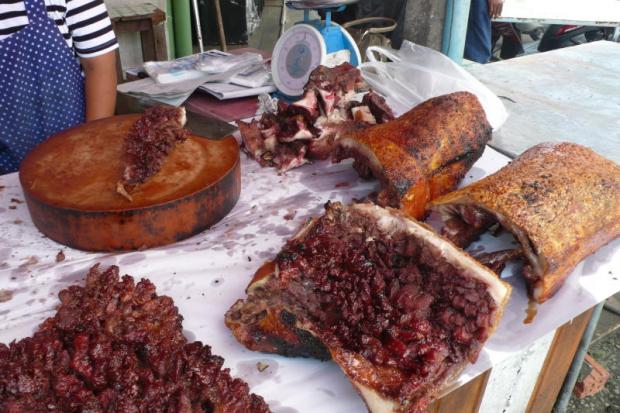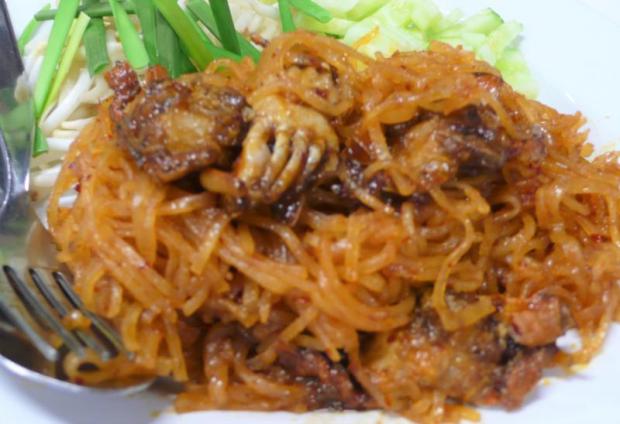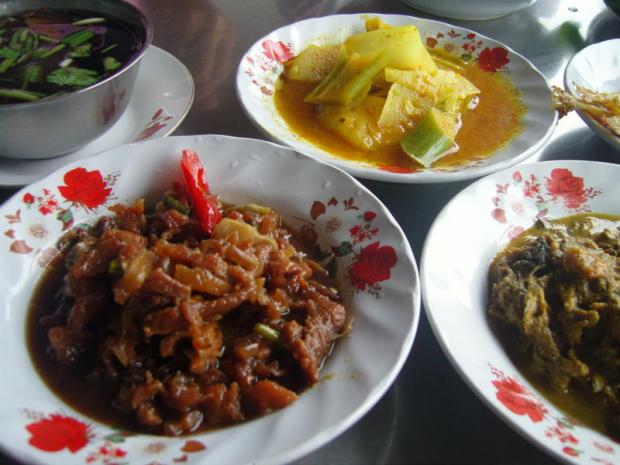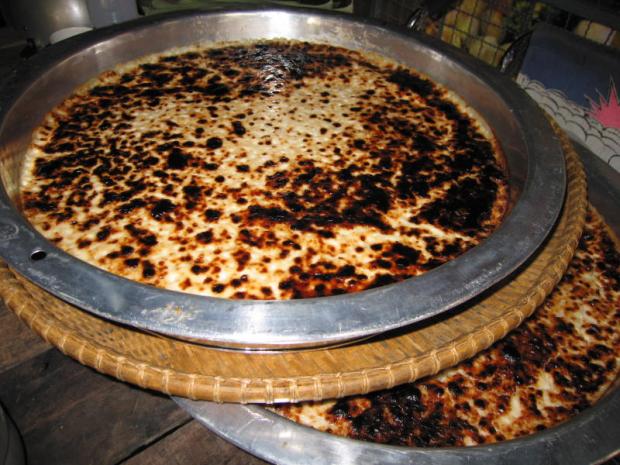Let's have a look at some regional food that is representative of different regions. Nasi dagang is a speciality in the three southernmost provinces of Pattani, Narathiwat and Yala. It consists of rice cooked in coconut milk, with salt, sugar, cumin, fenugreek, ginger and shallots. This type of rice is suitable for fish curry and chicken curry. In the past, it was typically reserved for important occasions, but now it's considered part of the regular cuisine.
Aside from nasi dagang, there is also golek chicken, which is chicken marinated with curry paste made from dried chilli, onion, garlic, shrimp paste, cumin, cinnamon and other ingredients, then mixed with coconut milk, fish sauce, tamarind paste and oil. The chicken is roasted wet to ensure a full flavour.
Liang beef noodles from Chanthaburi are noodles in a special broth, made with rew (Amomum villosum) root, a plant native to the province. It also features galangal, lemongrass, pickled garlic, pickled bean curd, bean paste, sugarcane and fish sauce. The noodles have a sweet taste. Another Chanthaburi speciality is sen chan pad pu (rice noodles with crab meat). It is similar to pad Thai, but the seasoning is made from dried chilli, shallots, sugarcane, tamarind paste and salt. This is mixed with noodles and, traditionally, kratoi crab (a small variety of crab). However, nowadays, as there are no more kratoi, blue crab is used instead.

Trang roasted pork. Suthon Sukphisit
Fried krabong is a food originally developed by the Tai Yai ethnic group from Mae Hong Son. Pumpkin is sliced into long pieces, mixed with a curry paste made from dried chilli, grated coconut, sugar, salt, coconut milk and crushed peanuts, and then deep fried. It is similar to the deep-fried banana from Thailand's central region.
These are just some examples. Other notable regional dishes include pad mee Korat from Nakhon Ratchasima, which is similar to pad Thai; Baan Singh boiled beef from Ratchaburi, a spicy beef stew; and Trang roasted pork.
It may be strange that, for a city with such a great reputation for food, Bangkok doesn't have much of these regional specialities. For example, khao soi, the classic Northern noodle dish, is hard to find in the capital. Even though many northerners live in Bangkok, we could barely find 10 khao soi eateries in the city. Chanthaburi's liang noodles can only be found in three shops. Bangkok isn't as open to different types of food as it likes to think it is. In reality, people can still be hesitant about trying new food.

Kuay jab yuan from Aranyaprathet. Suthon Sukphisit
Isan cuisine -- which can now be found everywhere in Bangkok -- took a long time before it became popular. As more people from Isan migrated to the city for work, they brought their local cuisine with them. They would set up stalls to sell to fellow Isan migrants. Bangkokians began to try som tam, larb nuea, soop normai (spicy bamboo shoots) and the like, and eventually developed a liking for them. Still, there are many Isan dishes that people in Bangkok don't eat, such as lu (larb with fresh blood) or khee pia, which is made from cow's intestines and has a bitter taste. The vegetables that are served in Isan restaurants in Bangkok are not the same as those from Isan because Bangkok people haven't developed a taste for them.
Southern food also took a long time before it became a hit due to its spiciness and pungency. It first came to Bangkok via Thon Buri, as there were many southerners living there. Southern food has to be made by people from the South (or so southerners claim). Food from Surat Thani, Nakhon Si Thammarat and Songkhla each have their own specific tastes and styles.

Chan noodles with crab from Chanthaburi. Suthon Sukphisit
Today, many eateries will serve certain southern dishes such as kang tai pla (fish curry), kua kling (stir-fried meat with chilli and herbs), stir-fried shrimp with shrimp paste and bitter bean, and liang leaf with egg. But they are never quite as good as those at authentic southern restaurants.
Local food tends to be best when it is made by local people. While the processes may not be a secret, they require certain instincts to pull off, which can be hard for non-locals to pick up. Bangkok doesn't grill chicken as well as Isan. Vietnamese food in Thailand isn't the same as Vietnamese food in Vietnam.
Regional food can find it difficult to break into Bangkok for several reasons. There may not be many natives of that region living in the city. Some food takes a long time to prepare or requires specific ingredients, not available in Bangkok. Cooking the food for sale may not be viable; if people aren't familiar with it, they won't buy it.
If local people miss their own food, they can cook it at home. Or they can go back to their home province. Transportation these days means that the journeys are easier, faster and more affordable.
Maybe the fact that some regional cuisine hasn't made it to Bangkok is a good thing. Some things should stay where they are, so that when we travel there, we can experience something original, mysterious and magical.

Southern cuisine. Suthon Sukphisit

